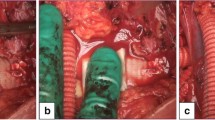Abstract
Objectives
Fibrin glue is used to reinforce anastomosis in aortic surgery. There has not yet been a consensus on how it should be applied optimally. This study aimed to define the optimal condition of applying fibrin glue.
Methods
In experiment 1, we determined the optimal condition for spraying fibrin glue using an expanded polytetrafluoroethylene graft within a needle hole. The length and area of the fibrin cap within the hole were measured. In experiment 2, methods for applying fibrinogen were assessed by comparing brushing and spraying. In experiment 3, swine aorta segments sutured with a Dacron graft were divided into the following three groups: nothing was applied; fibrinogen was sprayed and rubbed using brush. The aorta was clamped and blood was infused from an occlusion catheter inserted into the graft. The pressure at the first appearance of blood leak was recorded.
Results
In experiment 1, among the four groups divided by the pressure and distance of spraying, the fibrin cap area in the group with 0.075 MPa and 2-cm spray distance was significantly larger than that in the group with 0.15 MPa and 2 cm (P < 0.01). In experiment 2, the fibrin cap area in the brushing group was significantly larger than that in the spraying group (P < 0.05). In experiment 3, the capacity to resist endoluminal pressure was higher in the brushing and combined spraying group compared with that in the sequential combined spraying group (P < 0.01).
Conclusions
The brush and spray methods showed excellent hemostatic outcomes.






Similar content being viewed by others
References
Matras H, Dinges HP, Lassmann H, Mamoli B. Suture-free interfascicular nerve transplantation in animal experiments. Wien Med Wochenschr. 1972;122:517–23.
Spängler HP, Braun F, Holle J, Moritz E, Wolner E. The local application of fibrinogen and collagen for hemostasis in heart surgery. Wien Med Wochenschr. 1976;126:86–9.
Kram HB, Nugent P, Reuben BI, Shoemaker WC. Fibrin glue sealing of polytetrafluoroethylene vascular graft anastomoses: comparison with oxidized cellulose. J Vasc Surg. 1988;8:563–8.
Kheirabadi BS, Pearson R, Rudnicka K, Somwaru L, MacPhee M, Drohan W, et al. Development of an animal model for assessment of the hemostatic efficacy of fibrin sealant in vascular surgery. J Surg Res. 2001;100:84–92.
Seguin JR, Frapier JM, Colson P, Chaptal PA. Fibrin sealant improves surgical results of type A acute aortic dissections. Ann Thorac Surg. 1991;52:745–8 (discussion 8–9).
Nakajima T, Kawazoe K, Kataoka T, Kin H, Kazui T, Okabayashi H, et al. Midterm results of aortic repair using a fabric neomedia and fibrin glue for type a acute aortic dissection. Ann Thorac Surg. 2007;83:1615–20.
Minato N, Katayama Y, Yunoki J, Kawasaki H, Satou H. Hemostatic effectiveness of a new application method for fibrin glue, the “rub-and-spray method”, in emergency aortic surgery for acute aortic dissection. Ann Thorac Cardiovasc Surg. 2009;15:265–71.
Rousou JA. Use of fibrin sealants in cardiovascular surgery: a systematic review. J Cardi Surg. 2013;28:238–47.
Nakajima S, Fukuda T, Hasue M, Sengoku Y, Haraoka J, Uchida T. New technique for application of fibrin sealant: rubbing method devised to prevent cerebrospinal fluid leakage from dura mater sites repaired with expanded polytetrafluoroethylene surgical membranes. Neurosurgery. 2001;49:117–23.
Minato N, Shimokawa T, Katayama Y, Yamada N, Sakaguchi M, Itoh M. New application method of fibrin glue for more effective hemostasis in cardiovascular surgery. Jpn J Thorac Cardiovasc Surg. 2004;52:361–6.
Acknowledgements
We would like to thank Editage (http://www.editage.jp) for English language editing.
Author information
Authors and Affiliations
Corresponding author
Ethics declarations
Conflict of interest
The authors declare that we have no conflicts of interest.
Additional information
Publisher's Note
Springer Nature remains neutral with regard to jurisdictional claims in published maps and institutional affiliations.
Rights and permissions
About this article
Cite this article
Naganuma, M., Akiyama, M., Takaya, H. et al. Maximization of the sealing effect of fibrin glue in aortic surgery. Gen Thorac Cardiovasc Surg 68, 18–23 (2020). https://doi.org/10.1007/s11748-019-01155-x
Received:
Accepted:
Published:
Issue Date:
DOI: https://doi.org/10.1007/s11748-019-01155-x




